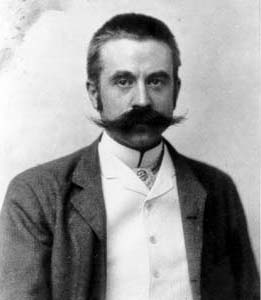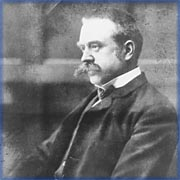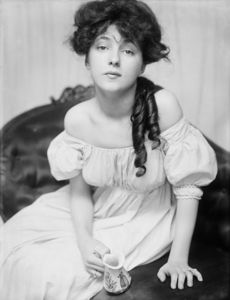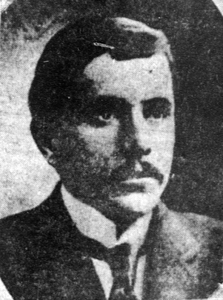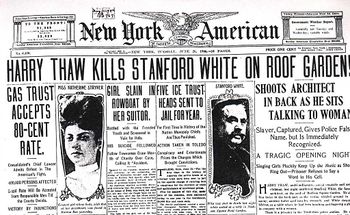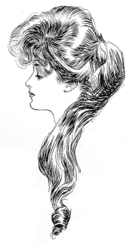Stanford White
Click here for Nexus:Evelyn Nesbit |
Stanford White (November 9, 1853 – June 25, 1906) was an American architect. He was also a partner in the architectural firm "McKim, Mead & White", the frontrunner among Beaux-Arts firms. He designed many houses for the rich as well as numerous civic, institutional, and religious buildings. His design principles embodied the "American Renaissance".
In 1906, White was shot and killed by the mentally unstable millionaire Harry Kendall Thaw, who had become obsessed about White's previous relationship with Thaw's wife, actress Evelyn Nesbit. This led to a court case which was dubbed "The Trial of the Century" by contemporary reporters.
Personal life
White, a tall, flamboyant man with red hair and a red mustache, impressed others as witty, kind, and generous. The newspapers frequently described him as "masterful", "intense", "burly yet boyish". He was a sophisticated collector of all things rare and costly, such as artwork and antiquities. He maintained a multi-story apartment with a rear entrance on 24th street in Manhattan. One green-hued room was outfitted with a red velvet swing, which hung from the ceiling suspended by ivy-twined ropes. There are conflicting accounts of whether this swing was in the "Giralda" tower at the old Madison Square Garden, or in the nearby building at 22 West 24th Street, but sources seem to concur that the swing was a feature of the 24th Street location.
From evidence in letters, including those of Augustus Saint-Gaudens to White, recent biographers have concluded that White was, at the very least, bisexual, and that the office of McKim, Mead & White was very much part of such a social circle. In respect to this, White's granddaughter has written that Stanford's eldest son (her father) was "unflinching in his awareness of Stanford's nature".
Murder
"The Trial of the Century"
- The Trial of the Century
White's presence at the roof garden theater of 'Madison Square Garden' on the night of June 25, 1906, had been an impromptu decision. White had originally planned to be in Philadelphia on business; he postponed the trip when his son, Lawrence, made an unexpected visit to New York. Accompanied by New York society figure James Clinch Smith, they dined at Martin's, near the theater, where Harry Kendall Thaw and his wife Evelyn Nesbit also dined. Thaw apparently saw White there.
That evening's theatrical presentation was the premiere performance of "Mam'zelle Champagne". During the show's finale, "I Could Love A Million Girls", Thaw approached White, produced a pistol, standing some two feet from his target, said, "You've ruined my wife", and fired three shots at White, hitting him twice in the face and once in his upper left shoulder, killing him instantly. Part of White's face was torn away, and the rest of his features were unrecognizable, blackened by gunpowder. The crowd's initial reaction was one of good cheer, as elaborate party tricks among the upper echelon of New York society were common at the time. However, when it became apparent that White was dead, hysteria ensued.
Thaw, a Pittsburgh millionaire with a history of severe mental instability, was a jealous husband who saw White as his rival. White had first inebriated and then raped an unconscious Nesbit when she was 16 and White was 47 years old. In the years following, White had remained a potent presence in Nesbit's life. However, by the time he was murdered, White had long since moved on to other lovers, and it is conjectured that White was unaware of Thaw's long-standing vendetta against him. White considered Thaw a poseur of little consequence, categorized him as a clown, and most tellingly, called him the "Pennsylvania pug" – a reference to Thaw's baby-faced features. In reality, Thaw both admired and resented White's social stature. More significantly, he recognized that he and White shared a passion for similar lifestyles. However, unlike Thaw, who had to operate in the shadows, White could carry on without censure, and seemingly, with impunity.
Nineteen-year-old Lawrence (Larry) Grant White was guilt ridden after his father was slain, blaming himself for his death. "If only he had gone [to Philadelphia]!" he lamented. Years later, he would write bitterly, "On the night of June 25th, 1906, while attending a performance at Madison Square Garden, Stanford White was shot from behind [by] a crazed profligate whose great wealth was used to besmirch his victim's memory during the series of notorious trials that ensued."
White was buried in St. James, New York.
News coverage
As early as the morning following the murder, news coverage became both chaotic and single-minded, and it ground forward with unrelenting momentum. William Randolph Hearst's newspapers played up the murder, and the associated legal proceedings became known as "The Trial of the Century". The rampant interest in the White murder and its key players was used by both the defense and prosecution in Thaw's murder trial to feed malleable reporters any "scoops" that would give their respective sides an advantage in the public forum.
Any person, place or event, no matter how peripheral to White's murder, was seized on by reporters and hyped as newsworthy copy. Facts were thin, but sensationalist reportage was plentiful in this, the heyday of tabloid journalism. The hard-boiled male reporters were bolstered by a contingent of female counterparts, christened "Sob Sisters", also known as the "Pity Patrol". Their stock in trade was the human-interest piece, heavy on sentimental tropes and melodrama, crafted to pull on the emotions and punch them up to fever pitch.
White, in death, was not spared the frenzy of printed invective, which not only excoriated him as a man, but questioned his professional achievements as an architect as well. "The Evening Standard" concluded he was "more of an artist than architect", and said his work spoke of his "social dissolution". The Nation was also critical: "He adorned many an American mansion with irrelevant plunder." The yellow press used lurid language to demonize White as "a sybarite of debauchery, a man who abandoned lofty enterprises for vicious revels."
Defenses
Few friends or associates came forward to publicly defend White. His close friend, sculptor Augustus Saint-Gaudens, was gravely ill and unable to speak out.
Richard Harding Davis, a war correspondent and reputedly the model for the "Gibson Man", was angered by the tabloid press, which, he was adamant, had distorted the facts. An editorial, which appeared in Vanity Fair, lambasting White and shredding his reputation, prompted Davis to pen a rebuttal. The article appeared on August 8, 1906, in Collier's magazine:
- Since his death White has been described as a satyr. To answer this by saying that he was a great architect is not to answer at all...what is more important is that he was a most kindhearted, most considerate, gentle and manly man, who could no more have done the things attributed to him than he could have roasted a baby on a spit. Big in mind and in body, he was incapable of little meanness. He admired a beautiful woman as he admired every other beautiful thing God has given us; and his delight over one was as keen, as boyish, as grateful over any others.
Autopsy
The autopsy report made public by the coroner's testimony at the Thaw trial revealed that White was seriously unwell at the time of his murder. In fact, he would have succumbed shortly to any of the various illnesses he suffered from: Bright's disease, incipient tuberculosis, and severe liver deterioration.
| Nexus: Evelyn Nesbit |
|---|
The following articles are related to "Evelyn Nesbit" as their nexus External links
|
Chat rooms • What links here • Copyright info • Contact information • Category:Root
